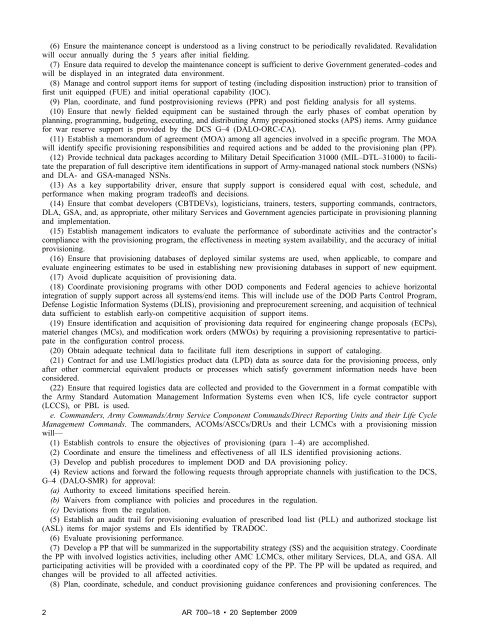Provisioning of U.S. Army Equipment - Army Publishing Directorate ...
Provisioning of U.S. Army Equipment - Army Publishing Directorate ...
Provisioning of U.S. Army Equipment - Army Publishing Directorate ...
You also want an ePaper? Increase the reach of your titles
YUMPU automatically turns print PDFs into web optimized ePapers that Google loves.
(6) Ensure the maintenance concept is understood as a living construct to be periodically revalidated. Revalidation<br />
will occur annually during the 5 years after initial fielding.<br />
(7) Ensure data required to develop the maintenance concept is sufficient to derive Government generated–codes and<br />
will be displayed in an integrated data environment.<br />
(8) Manage and control support items for support <strong>of</strong> testing (including disposition instruction) prior to transition <strong>of</strong><br />
first unit equipped (FUE) and initial operational capability (IOC).<br />
(9) Plan, coordinate, and fund postprovisioning reviews (PPR) and post fielding analysis for all systems.<br />
(10) Ensure that newly fielded equipment can be sustained through the early phases <strong>of</strong> combat operation by<br />
planning, programming, budgeting, executing, and distributing <strong>Army</strong> prepositioned stocks (APS) items. <strong>Army</strong> guidance<br />
for war reserve support is provided by the DCS G–4 (DALO-ORC-CA).<br />
(11) Establish a memorandum <strong>of</strong> agreement (MOA) among all agencies involved in a specific program. The MOA<br />
will identify specific provisioning responsibilities and required actions and be added to the provisioning plan (PP).<br />
(12) Provide technical data packages according to Military Detail Specification 31000 (MIL–DTL–31000) to facilitate<br />
the preparation <strong>of</strong> full descriptive item identifications in support <strong>of</strong> <strong>Army</strong>-managed national stock numbers (NSNs)<br />
and DLA- and GSA-managed NSNs.<br />
(13) As a key supportability driver, ensure that supply support is considered equal with cost, schedule, and<br />
performance when making program trade<strong>of</strong>fs and decisions.<br />
(14) Ensure that combat developers (CBTDEVs), logisticians, trainers, testers, supporting commands, contractors,<br />
DLA, GSA, and, as appropriate, other military Services and Government agencies participate in provisioning planning<br />
and implementation.<br />
(15) Establish management indicators to evaluate the performance <strong>of</strong> subordinate activities and the contractor’s<br />
compliance with the provisioning program, the effectiveness in meeting system availability, and the accuracy <strong>of</strong> initial<br />
provisioning.<br />
(16) Ensure that provisioning databases <strong>of</strong> deployed similar systems are used, when applicable, to compare and<br />
evaluate engineering estimates to be used in establishing new provisioning databases in support <strong>of</strong> new equipment.<br />
(17) Avoid duplicate acquisition <strong>of</strong> provisioning data.<br />
(18) Coordinate provisioning programs with other DOD components and Federal agencies to achieve horizontal<br />
integration <strong>of</strong> supply support across all systems/end items. This will include use <strong>of</strong> the DOD Parts Control Program,<br />
Defense Logistic Information Systems (DLIS), provisioning and preprocurement screening, and acquisition <strong>of</strong> technical<br />
data sufficient to establish early-on competitive acquisition <strong>of</strong> support items.<br />
(19) Ensure identification and acquisition <strong>of</strong> provisioning data required for engineering change proposals (ECPs),<br />
materiel changes (MCs), and modification work orders (MWOs) by requiring a provisioning representative to participate<br />
in the configuration control process.<br />
(20) Obtain adequate technical data to facilitate full item descriptions in support <strong>of</strong> cataloging.<br />
(21) Contract for and use LMI/logistics product data (LPD) data as source data for the provisioning process, only<br />
after other commercial equivalent products or processes which satisfy government information needs have been<br />
considered.<br />
(22) Ensure that required logistics data are collected and provided to the Government in a format compatible with<br />
the <strong>Army</strong> Standard Automation Management Information Systems even when ICS, life cycle contractor support<br />
(LCCS), or PBL is used.<br />
e. Commanders, <strong>Army</strong> Commands/<strong>Army</strong> Service Component Commands/Direct Reporting Units and their Life Cycle<br />
Management Commands. The commanders, ACOMs/ASCCs/DRUs and their LCMCs with a provisioning mission<br />
will—<br />
(1) Establish controls to ensure the objectives <strong>of</strong> provisioning (para 1–4) are accomplished.<br />
(2) Coordinate and ensure the timeliness and effectiveness <strong>of</strong> all ILS identified provisioning actions.<br />
(3) Develop and publish procedures to implement DOD and DA provisioning policy.<br />
(4) Review actions and forward the following requests through appropriate channels with justification to the DCS,<br />
G–4 (DALO-SMR) for approval:<br />
(a) Authority to exceed limitations specified herein.<br />
(b) Waivers from compliance with policies and procedures in the regulation.<br />
(c) Deviations from the regulation.<br />
(5) Establish an audit trail for provisioning evaluation <strong>of</strong> prescribed load list (PLL) and authorized stockage list<br />
(ASL) items for major systems and EIs identified by TRADOC.<br />
(6) Evaluate provisioning performance.<br />
(7) Develop a PP that will be summarized in the supportability strategy (SS) and the acquisition strategy. Coordinate<br />
the PP with involved logistics activities, including other AMC LCMCs, other military Services, DLA, and GSA. All<br />
participating activities will be provided with a coordinated copy <strong>of</strong> the PP. The PP will be updated as required, and<br />
changes will be provided to all affected activities.<br />
(8) Plan, coordinate, schedule, and conduct provisioning guidance conferences and provisioning conferences. The<br />
2 AR 700–18 20 September 2009

















